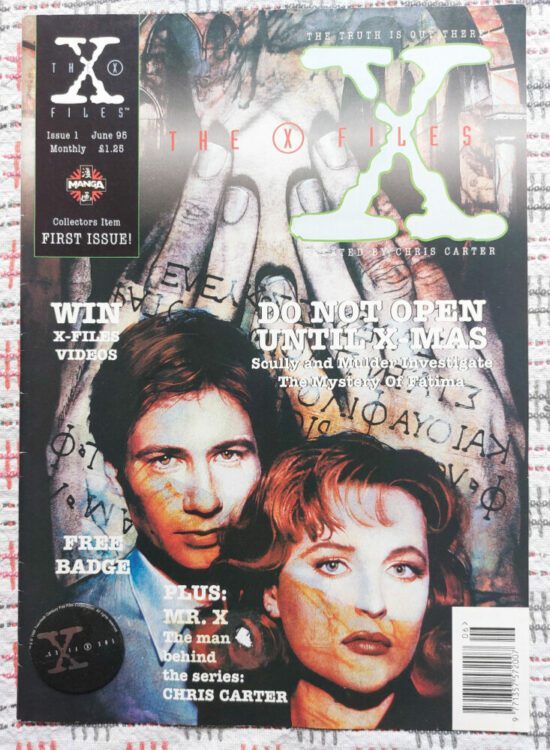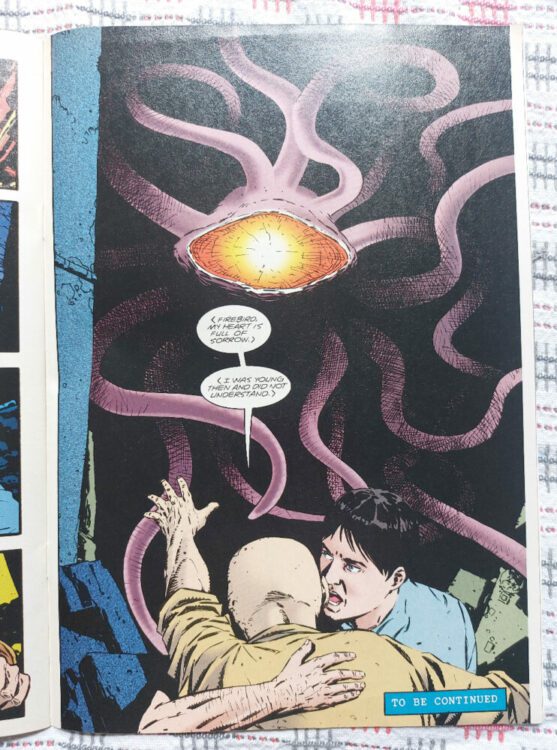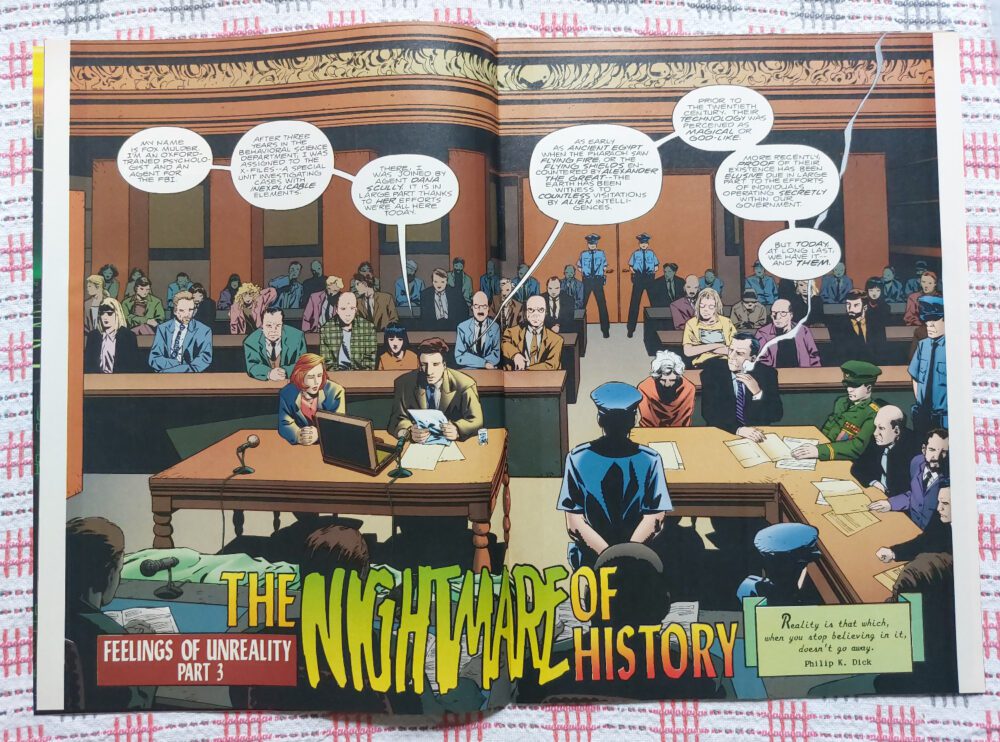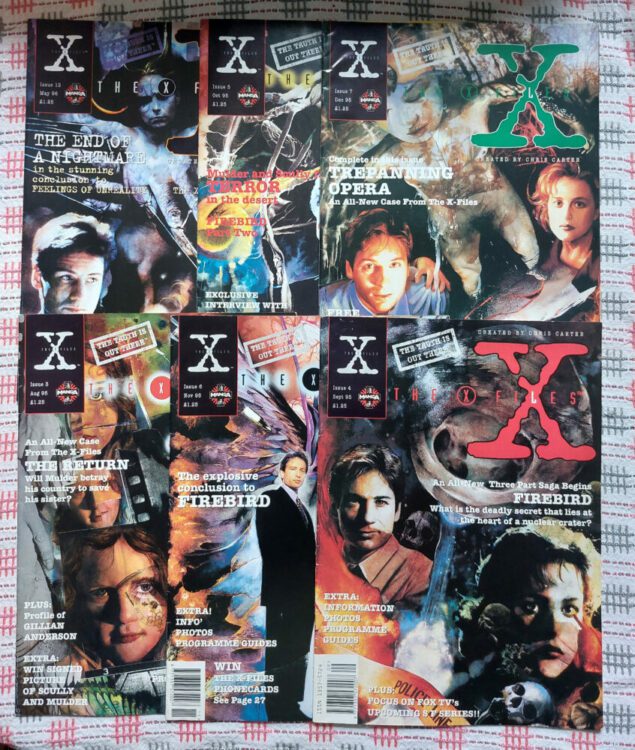The premise is simple: read one comic every day for the entire year. It seems like a simple task but there is no way that I read 365 comics last year, even if you count the individual issues in collections. So, this year, I am committing myself to this reading challenge, in the hope that I can broaden my reading habits and fully engage with my favorite hobby again.
“Mulder…It’s a flying saucer! I don’t believe it!” – Dana Scully in Not to be opened until X-Mas, from issue 1 of The X-Files
Looking back, it’s amazing how much Dana Scully sees early on, and yet writers play her as a skeptic for so long. The X-Files comic series is worse than the television show in that respect. At least in the show, Scully was always just around the corner or unconscious when the craziness happened so she could write it off as Mulder’s flight of fancy or overactive imagination. In the comic, they chuck flying saucers and cannibal priests at her all day long.
After reading Tank Girl last week, I had my box of older British comics out, and sitting on top was The X-Files, also published over here by Manga Publishing Ltd. The comic strips are reprints of the Topps Comics Production comics published in North America. Just like the television show there was a delay between the America publication and the UK release. The comics had a 6 month delay, the television show about 12 months (depending how you watched it).
The X-Files was a revolutionary show, or at least it felt like it at the time. It was a series that drew a massive audience, and in the UK it became one of the top-watched shows, even beating The Simpsons in the ratings (the first video releases had some shops doing midnight openings and they sold 250,000 in the first week of release). The first and second seasons were amazing with some fascinating ideas and brilliant character work, especially for the quest characters who only popped up now and then. Actors Gillian Anderson and David Duchovny were superb individually, but even better together. Re-watching it now with my son (10 episodes in) and I forgot how kick-ass Scully was.
But what about the comics?

Credit: Manga Publishing Ltd
The majority of the comics I own were written by Stefan Petrucha. I am not familiar with any of his other work, so I can’t tell you how The X-Files fits his style. The artist, on the other hand, is a lot more familiar: Charlie Adlard, who we all know best from his impressive run on Warheads from Marvel, right?
In 1995, X-Files #1 came out, and — if you watched the show — how could you resist it? The front cover for the debut issue, produced by Miran Kim, captures everything that the show represented. It’s dark and moody, mysterious and alluring, and tempts the reader with everything a specialist magazine should have. Plus a badge.
The Manga Publishing Ltd X-Files title was a proper fan magazine with creator/cast interviews, episode guides, and news about shows or films related to the series. The majority of the pages were taken up with the comic strip which, as one reader points out in the letters page of issue 3, “seems to be well handled both in art and script.” High praise indeed. But Peter from Cheshire is not wrong: Petrucha’s scripts are perfect X-File adventures for the comics. He brings the lore building and the myth making of the series to his stories which are more over the top than those seen in the early couple of seasons of the show (and that is saying something). And yet, they don’t reach a ridiculous level that would put fans off.
The aliens and visions are more elaborate in the comics than in the show, because the nature of the format allows the fantastical to be bigger and easier to interact with. Special effects, especially CGI, have a problem with the interaction of live-action characters and created environments, creatures, or even other characters. Comics do not have that problem. Hence the Cthulhu-esq creature in the three-part story “Firebird”. All those tentacles and the brightly burning single eye disintegrating everything it looks at would be difficult to do realistically on television but Adlard brings it to life with a believable flair.

It seems that a lot of the stuff I read brings me back to adaptation; maybe that’s the nature of comics in general because it is such a trans-media format. Almost from the beginning, comic strips have been branching out into other media and adapting stories from every source possible. It’s not really surprising that many of the great comics have links to other media productions. Obviously, with The X-Files, the television show came first, but there wasn’t much of a gap between the airing of season one and the release of issue one. Dave Hughes, writer for The X-Files magazine, doesn’t see the title as a “mere comic book adaptation.” Instead, he highlights that they “are all original stories reflecting the more intelligent and uncharacteristic devices used in the show that inspires them” (from The Uncanny X-Men article in issue 13). But I feel that is the purpose of all adaptation. With this statement, Hughes is dismissing direct adaptations, which is a disservice to some great comics, such as the 1985 adaptation of Dune published by Marvel. It also undermines a project by Topps to publish direct adaptations of the television episode. Starting with an issue zero taster in 1996, Topps published a run of nine issues before fizzling out.

As Hughes pointed out, however, the writers focused on elements of the show beyond the story and characters. The visual tone and manipulative storytelling of the television series are strong features of the comic. Adlard has a gritty style that perfectly suited the tales Petrucha was telling and, despite some fan grumbles, the inconsistency in the character likenesses do not hamper any of the narratives. In the Hughes article from issue 13, Petrucha is quoted as saying “If people can’t get over the likeness problem, they aren’t really comic readers – they’d rather have a virtual photostory. [..] I’ve seen plenty of great licensed stuff where the likenesses are pretty inaccurate – the Cam Kennedy Star Wars stuff, for instance – but where the artwork is just stunning.” Hear, hear, I say.
There is an obsession with accuracy and fidelity in comic book adaptations, and character likenesses is a part of that. It’s interesting to see that this is not a new conversation, and that it was being discussed 30 years ago in relation to this comic series. But, as Petrucha alludes to, the ability to perfectly render an actor’s face does not make for great comic book storytelling. Adlard’s artwork, however, does make for perfect storytelling. He manages to breathe life into the heavy worded scripts, packed with exposition and journal/report style narration, and brings a dynamism to the page that isn’t easy to do with this type of script.

This week I’ve read issues #1 to 12, and I still have a further eight to read from my collection (the series ran for over 40 issues originally). However, these first 12 make a wonderful collection, because the final story, “Feelings of Unreality”, is a three-parter that brings the previous nine issues to a conclusion, sort of. The 12 issues work like a television series with a beginning, middle, and end, featuring standalone stories, but also elements of the wider picture. They showcase the talents of the writer and the artists, and add a worthwhile entry into the X-Files saga.
I guess the question is, are The X-Files comics worth reading today? If you are a fan of the series, or a fan of the alien/government conspiracy genre, then they are definitely worth getting your hands on. There is a specific mood throughout the stories that might not appeal to some, but Scully and Mulder are as engaging on the page as they are on the screen. It’s just harder to hide the unknown when it’s so big and bombastic, but I guess Scully suffered some kind of amnesia around this point in time…
…the truth is out there!

That’s comics #223 to 229 covered, with a bunch to spare. I seem to have forgotten the format I was following for these posts but I’ll try harder next week.

